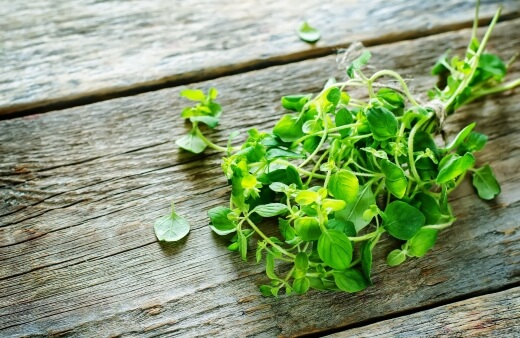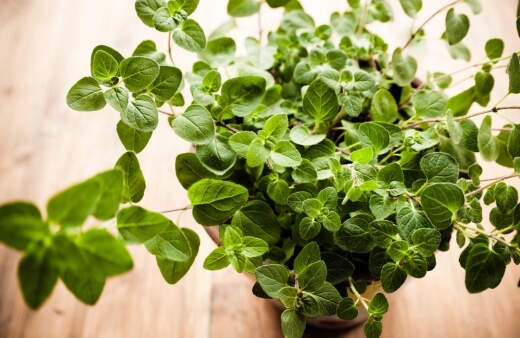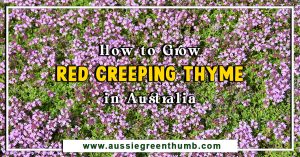Oregano is a peppery herb with a distinctly Mediterranean flavour, and an even better aroma. While it’s most popular in Italian and Greek cooking, it's useful for pretty much any saucy dish, and helps to elevate the flavour of tomatoes to a whole new level.
While Mediterranean herbs like this might seem complicated to grow, it's actually a really robust garden plant, and grows just as well on a kitchen windowsill as it will in a well-drained border.
In this ultimate growing guide, we will discuss everything you need to know about growing oregano in Australia.
More...

Family: | Lamiaceae |
|---|---|
Genus: | Origanum |
Species: | O. vulgare |
Origin: | Mediterranean |
Common Names: | Oregano, Wild marjoram |
Location: | Outdoor |
Type: | Herb |
Height: | 30-80 cm |
Width: | 45-90 cm |
Sun requirements: | Full sun to partial shade |
Foliage Colour: | Grayish-green |
Flower Colour: | Pink or purple |
Flowering: | Late spring or early summer |
Edible Parts: | None |
Maintenance level: | Low |
Poisonous for pets: | Not toxic to pets |
What is Oregano?
Oregano is a member of the mint family and is known for its pungent, earthy flavour and scent. Origanum vulgare, common oregano, is native to the Mediterranean, making it ideally suited for much of Australia too.
Oregano is a perennial herb that grows to about 25 cm tall, with a spread of 30-40 cm when mature. Some varieties can reach up to 80 cm in height and produce small, pink, or purple flowers in summer.
Oregano leaves are used fresh or dried in cooking, and the flowers can be added to salads both for decoration and flavour. It is also known for its medicinal properties, making it a staple in traditional medicine.
Natural Habitat of Origanum vulgare
Oregano thrives in hot, dry climates and is common in the Mediterranean region, but has naturalised in most parts of the world, where it grows wild in rocky, well-drained soils.
It prefers full sun and well-drained soil and can tolerate any reasonably neutral soil pH.
How to Grow Oregano in Australia

Oregano is easy to grow and can be grown indoors or outdoors. We’ve put together a simple guide for growing oregano in both conditions below, but for best results, grow oregano outdoors, where it will produce fresh, tasty leaves for years.
Growing Oregano Indoors
To grow oregano indoors:
- Choose a pot with good drainage and fill it with a well-draining potting mix (garden compost, mixed with perlite, or sieved sandy soil mixed with grit).
- Sow the seeds or transplant the seedlings 6-8 inches apart.
- Place the pot in a sunny location, such as a north-facing window.
- Water the plant only when the soil is dry to the touch.
- Fertilise the plant every four weeks in spring and summer with any balanced fertiliser (NPK of 10-10-10, 5-5-5, etc).
- Pinch back the plant regularly to promote bushier growth.
How to Grow Oregano Outdoors
Oregano is convenient when grown indoors but will last much longer outdoors in a well-drained border, or even a rockery. To grow oregano outdoors, follow the steps below, but be sure to adapt the soil conditions to your own garden:
- Choose a sunny location with well-drained soil.
- Sow the seeds or transplant the seedlings 6-8 inches apart.
- Water the plant only when the soil is dry to the touch.
- Fertilise oregano every four weeks in summer with a balanced fertiliser.
- Pinch back the plant regularly to promote bushier growth.
- Avoid watering in winter, and try to keep the soil reasonably dry from autumn to early spring, as cold wet temperatures put the whole plant at risk of fungal problems.
How to Propagate Oregano
Oregano can be propagated from seeds or cuttings, but the cheapest method is to buy a potted oregano plant from your local grocery store and use that to create hardier cuttings for planting outdoors.

Oregano Propagation from Seeds
Propagating oregano from seed is a fairly slow process to begin with, but you can get your first harvest after a couple of months and will have a wider choice of varieties to choose from.
- Sow oregano seeds in any well-drained soil.
- Place your tray or pots in a bright, sunny spot, and keep the soil moist until the seedlings emerge (2-4 weeks).
- Once the seedlings have emerged, transplant them into individual pots or into the ground.
Propagating Oregano from Cuttings
Taking oregano cuttings is incredibly easy, but you do need to choose the right materials and cut at the right time of year for best results.
Like rosemary or thyme cuttings, oregano produces the best cutting material in mid-spring, when there are plenty of fresh green shoots, and before flowering or buds have started to show.
- Take a 3-4 inch cutting from the tip of a healthy oregano plant.
- Strip the leaves from the bottom two-thirds of the stem.
- Dip the cut end of the stem in rooting hormone powder and plant it in a pot filled with well-draining soil.
- Place the pots in a propagator, or any covered space to retain moisture. If you don't have a propagator or cold frame, cover pots with cling film or plastic bags.
- Water the cutting only when the soil is dry to the touch.
- Keep the pot in a warm, sunny location, but out of direct light until new leaves show.
- After 4-6 weeks, the cutting should have rooted and can be transplanted into its permanent location.
How to Care for Oregano
Oregano is a low-maintenance herb, and once it's established, there’s not much to do other than an annual prune to maintain its form. However, we’ve found that a light mulch every two years helps to improve leaf production, and regular pruning in early spring will promote much more vigorous flowering to make the most of its ornamental qualities.

Mulching and Feeding Oregano
Adding a light mulch around the base of oregano with any organic material will help retain moisture and suppress weeds through spring and summer. Avoid mulching in winter as this will promote moisture retention around the base of these drought-tolerant plants and increase the chance of winter rot.
Pruning and Repotting
Oregano benefits from regular pruning to encourage bushier growth and prevent it from becoming too woody. Pinch off the tips of the stems regularly to promote side shoots, and a more manageable shape, and trim back any leggy or dead stems.
Oregano can be repotted in spring if it outgrows its container or if the soil becomes compacted.
Caring for Oregano Over winter
Oregano is a perennial herb in warmer climates, but it may die back in winter in colder regions. This isn’t due to frost but is a result of dampness. Like sage and rosemary, oregano is frost tolerant, but cold and wet conditions are a surefire way to kill it off.
To protect the plant from winter damp, move oregano indoors, or cover it with fleece to stop too much rainfall from damaging the roots in winter.
Oregano Pests and Diseases
Oregano is relatively pest free. As an aromatic herb, it actively repels most common garden pests, and can even be used to discourage them on other plants. However, it can still be affected by some common problems as a result of over-watering, or poor drainage.
Root rot
Root rot is caused by overwatering or poorly-draining soil. To prevent root rot, make sure the soil is well-draining and don't water too frequently.
Powdery mildew
Power mildew is a common fungal disease that causes a white, powdery coating on the leaves. It can be controlled with fungicides or by removing affected leaves.
Avoid growing oregano around cucumbers or squashes, as mildew is very likely on these plants and can quickly spread.
Leaf spot
Leaf spot is a general term for a variety of fungal diseases that causes dark spots on the leaves of oregano and other plants. It can be controlled with organic fungicides like neem oil, or by removing affected leaves.
Oregano Frequently Asked Questions

Can I grow oregano from seeds?
Oregano can be grown from seed, and you’ll have more varieties to choose from too. Sow the seeds indoors in late winter or early spring, or outdoors in spring after the last frost.
Can oregano be grown in a container?
Oregano can be grown in a container. Choose a pot that's at least 8 inches wide and use a well-draining potting mix. To aid drainage, and reduce the risk of over-watering row oregano in terracotta pots, which allows excess moisture to drain through their walls, and will discolour if they are too damp.
How often should I prune my oregano plant?
Prune your oregano plant at least once a year in spring to encourage bushier growth and prevent it from becoming too woody. Pinch off the tips of the stems regularly to promote branching, and trim back any leggy or dead stems.
Interested to growing more herbs? Check out our herb growing guide list below:
Enjoy the Benefits of Growing Oregano
Oregano is a versatile and easy-to-grow herb that adds flavour in its own right but is most useful for its ability to boost the flavour of other fruits and veggies. Whether you choose to grow it indoors or outdoors, Oregano requires minimal maintenance and can thrive in a range of conditions.
With the right care, you can enjoy fresh oregano throughout the year, and even propagate new plants from cuttings or seeds to create gorgeous ornamental features, making the most of the gentle blue flowers in summer.
Published on May 11, 2023 by Maisie Blevins
Last Updated on February 23, 2024




